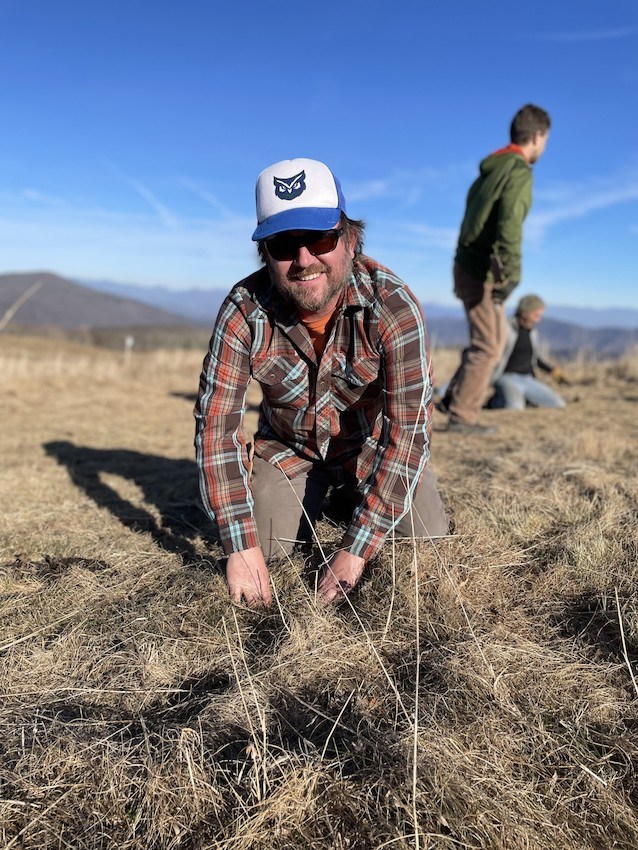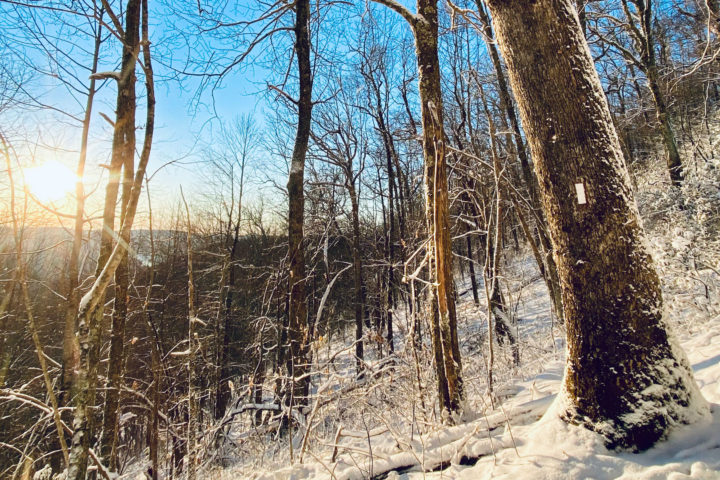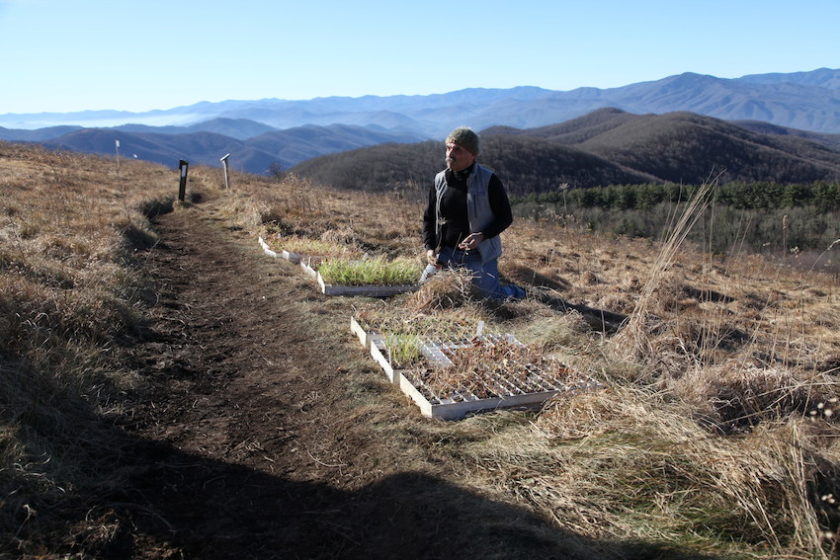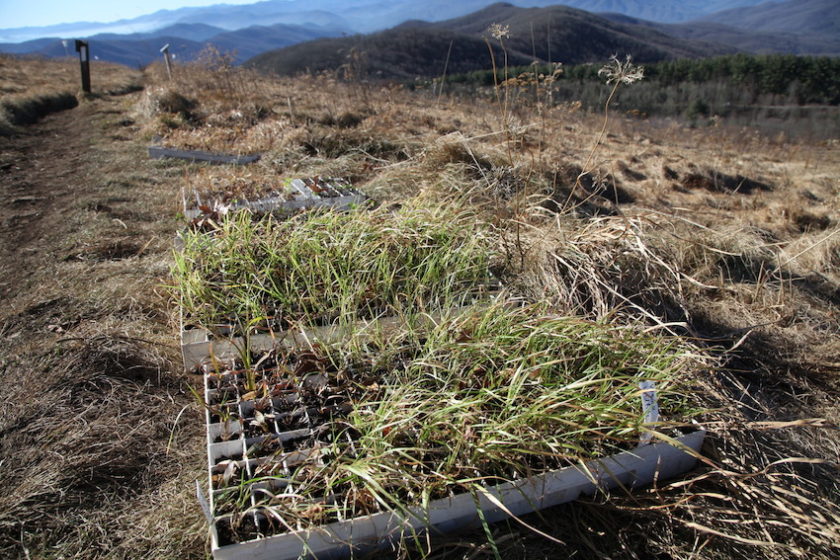By Matt Drury, Associate Director of Science and Stewardship
An Act of Love
January 28, 2022
Love for a place can have many origins. It can happen on the first visit or the fortieth. It may be the result of a special encounter with an animal or human, a magical sunset, or seeing the peak of wildflower season. These places can provide solace from life’s difficulties and inspiration for how to best navigate them. If any place in your world can provide this, I offer this advice: love it fully. You probably already do. Realize it and contemplate what showing love for that place looks like to you.
I have the privilege of being able to help manage natural resources along the Appalachian Trail (A.T.), having a job where I get to help protect places I love. One of those places happens to be one of the most beloved places on the entire Trail: Max Patch. Most visitors who have stepped foot on this scenic bald understand why it is so cherished. It offers panoramic views of the Great Smoky Mountains and surrounding Appalachian Mountain range, rewarding hiking opportunities, and dazzling sunsets and sunrises.
 At one time, Max Patch was cleared for cattle to graze, turning it into a man-made grassy bald. The Appalachian Trail Conservancy (ATC) has been involved with the management of Max Patch since its acquisition in the early 1980s. While this iconic bald has always been a popular destination for hikers and campers alike, Max Patch began to see a dramatic increase in visitor numbers starting in 2017, and resource damage was becoming increasingly apparent. Some folks began to say that Max Patch was being “loved to death,” but many of the impacts I witnessed did not resemble love.
At one time, Max Patch was cleared for cattle to graze, turning it into a man-made grassy bald. The Appalachian Trail Conservancy (ATC) has been involved with the management of Max Patch since its acquisition in the early 1980s. While this iconic bald has always been a popular destination for hikers and campers alike, Max Patch began to see a dramatic increase in visitor numbers starting in 2017, and resource damage was becoming increasingly apparent. Some folks began to say that Max Patch was being “loved to death,” but many of the impacts I witnessed did not resemble love.
The impacts were a combination of both overuse and a lack of understanding (or care) of how to reduce impacts to the environment. Fire rings side-by-side were scattered across the summit, social trails trampled habitat restoration efforts and caused erosion issues, and many arrived after a long drive unprepared to use the bathroom outdoors in a responsible manner. Those seeking to enjoy nature on weekends with pleasant weather were instead met by the noise and bustle of large crowds. For many, the extent of the issue became clear when photos like this one began to circulate online.
To help mitigate these impacts, the ATC along with its partners at the U.S. Forest Service (USFS) and Carolina Mountain Club (CMC) started the Max Patch Visitor Use Management (VUM) Committee in 2017. Results to date include a new kiosk, maps, signage, dramatic decreases in the use of closed trails, increased wildlife habitat quality, a highly successful Trail Ambassadors program, and, most notably for the A.T. visitor, a forest closure order for all of Max Patch, including a ban on certain activities like camping until June 2023. Through these efforts, Max Patch is showing signs of healing as social trails are disappearing, fires scars are fading and impacted areas are revegetating.
Beyond modifying the visitor experience, there is also a focus being placed on restoring Max Patch by enhancing the natural benefits of the area. For the last decade, Max Patch has been managed to provide high-quality early successional wildlife habitat while preserving the views that make this mountain such a beloved place. This management includes mowing and cutting woody encroachment and planting native wildflowers and grasses in the place of the non-native species remnant from Max Patch’s pastoral past.
In 2018, the Committee began work to re-establish native wildflowers and grasses to benefit native pollinators, songbirds, and of course the human visitor experience. Pollinators and birds like what people like, seasonal color and structure, people appreciate the aesthetics, and wildlife appreciate the forage and cover they provide. Since this time, nearly 4,000 plants and 50 pounds of seed have been planted to enhance the wildlife habitat of this area.
What also makes this work special (and important) is that these plants are not only native to the region, but that they are native genotypic plants — this means their seed came from this area of the national forest in western North Carolina, and not just a native species that may have come from a far-off place. This is important because the genetics of these plants have evolved on the landscape and will be more adapted to the site conditions on Max Patch, making them more resilient and persistent on the landscape.
So how can we manifest the love we have for these special places? Taking great care of a place is an act of love, it is as simple as that. My career is dedicated to caring for the places we all love, such as Max Patch. It’s sharing values and skills with interns, new volunteers and partners that I bring out for project work, inspiring service and appreciation for these beloved places. You can help show love for places too. Learn and practice Leave No Trace by packing out trash you find while on a hike, volunteer with a local Trail maintaining club or conservation group or find a job opportunity dedicated to protecting these beloved places for all to enjoy!
Discover More

JOIN OUR EFFORTS
Ways to Volunteer
Volunteers are the heart and soul of the Appalachian Trail, and there are many opportunities for you to give back to the Trail you love so much.

BACK TO THE BASICS
Leave No Trace
Wondering how you can take care of outdoor places like the Appalachian Trail (A.T.)?

ATC STAFF
Looking Back, Looking Forward
We at the Appalachian Trail Conservancy (ATC) are proud of the impact we made together in 2021.








